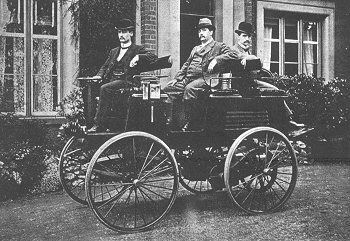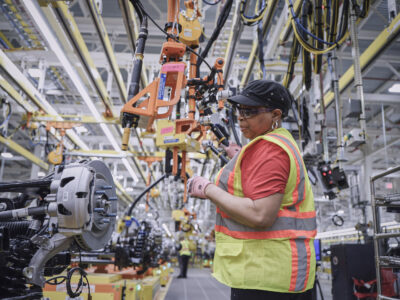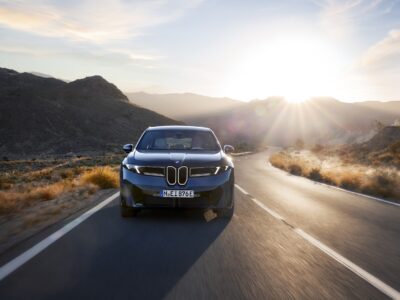Electric vehicles (EVs) seem like a modern marvel. The earliest you might remember seeing or hearing about one is the early to mid-2010s. Maybe you were one of the first believers in Tesla and bought one when they were still a niche brand.
However, EVs are not a new idea. Had it not been for developments in transportation and the discovery of cheap oil, there’s a chance they would’ve become the preferred power choice among early 20th-century motorists.
Early Concepts
Eighteenth-century thought leaders like Benjamin Franklin designed EV concepts but never built one. It wouldn’t be until the early 19th century that EVs emerged as a means of transportation.
The electric car motor was invented by Hungarian physicist Ányos Jedlik in 1828. Jedlik did build a small car, but it wouldn’t be him to capture the world’s attention. That would be Scottish inventor Robert Anderson. Anderson developed a crude electric carriage in the 1830s, without horses or oxen to carry it.
Another Scottish inventor, Robert Davidson, followed with the electric locomotive in 1837. Davidson debuted the locomotive at the Royal Scottish Society of Arts and later tested it on the Edinburgh and Glasgow Railway.
Though Anderson and Davidson’s invention proved the capability of electric power in transportation, they were not very fast and couldn’t carry burdensome loads such as groups of people. Each ride of the locomotive also required new batteries, known then as galvanic cells. Sources say rail workers destroyed Davidson’s invention out of fear of losing their jobs.
Early EVs got an upgrade when rechargeable batteries were created in 1859. Gaston Planté, a French chemist, developed the lead-acid battery which could be recharged.
Planté debuted his batteries at the French Academy of Science in 1860. This invention set the standard for modern car batteries, not exclusively EVs.
Planté’s creation was monumental, but his design was too large for early automobiles. His countryman, chemist Camille Faure, redesigned the batteries in 1881. His improvements made them lighter, allowed them to retain more charge, and found a way to manufacture them on an industrial scale.

Photo Courtesy Jacques Cattelin/Wikimedia
Around the same time as Faure’s improvements, the first electric people-carrying machine was tested on the streets of Paris by Gustave Trouvé. This device wasn’t the automobile, though Trouvé’s invention would be adapted for marine propulsion.
The ‘First’ Electric Car
The first “practical” electric automobile is believed to have been invented in 1884 by Englishman Thomas Parker. Parker, credited with inventing the London Underground, built his first electric car in Wolverhampton. Sources say documented proof didn’t emerge until 1895. EVs hadn’t become mainstream yet, but they were more prominent in early Industrial mass transportation.
Everything changed in 1886 when Carl Benz created the first gasoline-powered automobile.
Despite Benz’s triumph, electric cars were still being innovated. Along came William Morrison, a Scottish chemist living in Des Moines, Iowa, with his version of the electric carriage. He filed the patent on his prototype in 1890.
Morrison built a custom lightweight battery in 1887. He fitted it to a buggy, exhibiting his invention at the 1893 Chicago World’s Fair — the first time an electric automobile was displayed in the United States.
Morrison’s electric car could only reach 14 mph. Morrison’s car was up against the competition of bicycles, tricycles, and quadricycles, which were becoming popular in the Industrial U.S. Still, there was significant interest in “electrified wagons.”
The car boom from the 1890s to 1910s greatly increased public interest in personal vehicles. EVs were still being put to use. In London, taxis were run on batteries until the very end of the 19th century. New York City had 12 electric hansom cabs built by the Electric Carriage and Wagon Company, which would later become the Electric Vehicle Company. This firm was an early producer of EVs.
It seemed like electric cars would beat out gas power during this time. The smell and noise of early internal combustion engines (ICEs) were a key selling point for electric automobiles. They also didn’t require gear changes or a manual start. During this time, Frenchmen Louis Antonie Krièger invented regenerative braking, allowing batteries to recharge as they slowed down.

Photo Courtesy Wikimedia
The rise of EVs in 19th-century American and European cities created a mass appeal. Studebaker, the famous wagon company, had long been hailed as a superior carriage builder. A plucky electrical engineer from New Jersey had an idea: electrify them.
Thomas Edison and his pal Henry Ford created their own electric Studebaker in 1901. However, Edison and Ford agreed electric power wasn’t at a scale that supported full-electric driving. They endorsed the gasoline engine for its range and a car’s ability to carry fuel canisters. Batteries weren’t readily available for swapping, and public charging stations hadn’t been invented yet.
Ford, as we know, opened his own car company and created the assembly line factory.
The 1890s to 1910s were the “golden age” of early EVs. There were several documented uses of them in public transportation. When personal automobiles were made available, electric power was favored. They were marketed particularly toward ladies for the driving ease and being much less cumbersome than gas cars. There were over 300 EV manufacturers until 1942.
Early EVs’ Decline
However, the 1920s saw a lot of changes in personal transportation. More roads were laid down in the U.S., connecting a country that spanned a whole continent. Vehicles with better range were needed. Electric power wasn’t strong enough to get early motorists very far. EVs were also slower, only reaching 20 mph maximum. ICEs could get closer to 50–60 mph.
There were other factors that contributed to the decline in the popularity of early EVs. World War I happened, and the military might of England, France, Germany, Russia, and the U.S. ran on petroleum-based vehicles. In 1907, the Electric Vehicle Company also folded due to severe mismanagement, harming the reputation of the EV business.
The discovery of cheap petroleum across the globe created affordable gas, increasing the reliability of internal combustion.
Inventions like the electric automobile starter and the muffler improved the ICE experience.
Ford’s assembly line also lowered the price of ICE cars, while EVs remained expensive. By 1923, his Model T — which came out in 1908 — cost below $300. Even though there is documented evidence that Ford purchased his wife, Clara, a Detroit Electric car in 1914, he became a staunch supporter of ICEs. Clara’s electric car cost double the price of the 1914 Model T.

Photo Courtesy Wikimedia
The Great Depression certainly didn’t help things, and by the time World War II rolled around, much of the industrialized world had switched to internal combustion. Both sides of the war used gas-powered tanks, planes, naval vessels, and personal transport for prominent political leaders. The postwar world doubled down on gas-powered cars being readily available to everyone, particularly in the U.S., which emerged as one of the postwar global economic superpowers.
EVs seemed on track to become the preferred transportation choice prior to a few significant international events and the discovery of cheap petroleum. They would fade into obscurity but weren’t entirely out of the minds of auto executives. We’ll see what happened over the next half-century in Part 2.





